Smoking Cessation in Workplace: Programs and Policies
VerifiedAdded on 2020/04/29
|15
|3171
|76
Report
AI Summary
This report examines the implementation and effectiveness of smoking cessation programs in the workplace, with a specific focus on the mining industry. The study begins by highlighting the significant health risks associated with smoking, particularly in environments where workers are exposed to additional particulate matter. It then presents a literature review, exploring existing research on smoking cessation interventions, workplace policies, and their impact on employee health. The report employs a secondary research design, analyzing data from peer-reviewed journals and databases to evaluate the benefits of smoking cessation programs. The research question focuses on the evidence that smoking cessation programs can reduce the number of smokers in the workplace compared to minimal or no intervention. The report also discusses the theoretical framework, methods, and materials used in the research, including the PICO analysis and inclusion/exclusion criteria. It emphasizes the importance of policies, supportive programs, and communication in promoting smoking cessation. The analysis of the data indicates the effectiveness of workplace-based smoking cessation support activities and smoking cessation among employees. Overall, the report aims to provide insights into creating and implementing effective smoking cessation strategies within the mining industry to improve employee health and reduce the incidence of smoking-related illnesses.

Running head: SMOKING CESSATION IN WORKPLACE
Smoking cessation in workplace
Name of the student
University name
Authors’ note
Smoking cessation in workplace
Name of the student
University name
Authors’ note
Paraphrase This Document
Need a fresh take? Get an instant paraphrase of this document with our AI Paraphraser
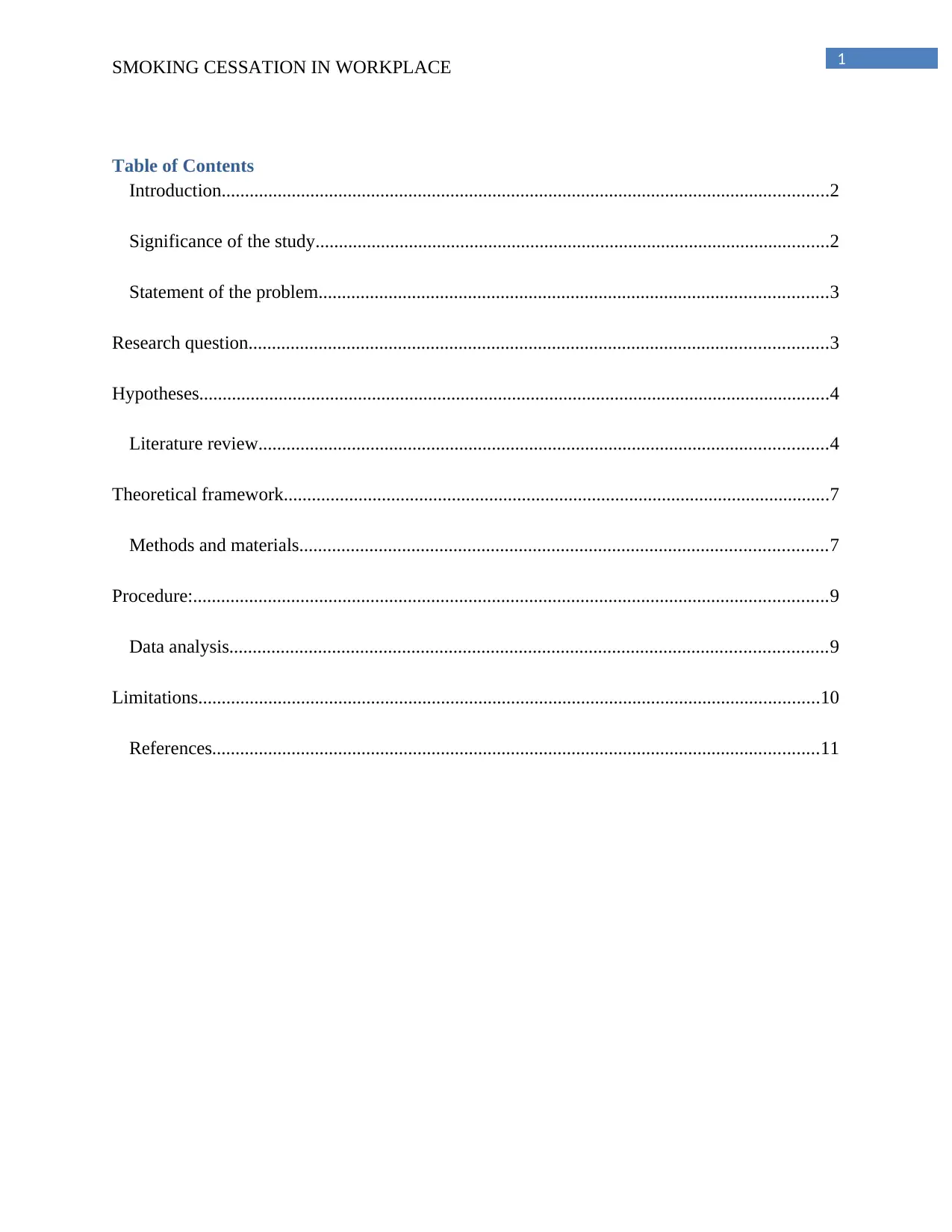
1SMOKING CESSATION IN WORKPLACE
Table of Contents
Introduction..................................................................................................................................2
Significance of the study..............................................................................................................2
Statement of the problem.............................................................................................................3
Research question............................................................................................................................3
Hypotheses.......................................................................................................................................4
Literature review..........................................................................................................................4
Theoretical framework.....................................................................................................................7
Methods and materials.................................................................................................................7
Procedure:........................................................................................................................................9
Data analysis................................................................................................................................9
Limitations.....................................................................................................................................10
References..................................................................................................................................11
Table of Contents
Introduction..................................................................................................................................2
Significance of the study..............................................................................................................2
Statement of the problem.............................................................................................................3
Research question............................................................................................................................3
Hypotheses.......................................................................................................................................4
Literature review..........................................................................................................................4
Theoretical framework.....................................................................................................................7
Methods and materials.................................................................................................................7
Procedure:........................................................................................................................................9
Data analysis................................................................................................................................9
Limitations.....................................................................................................................................10
References..................................................................................................................................11
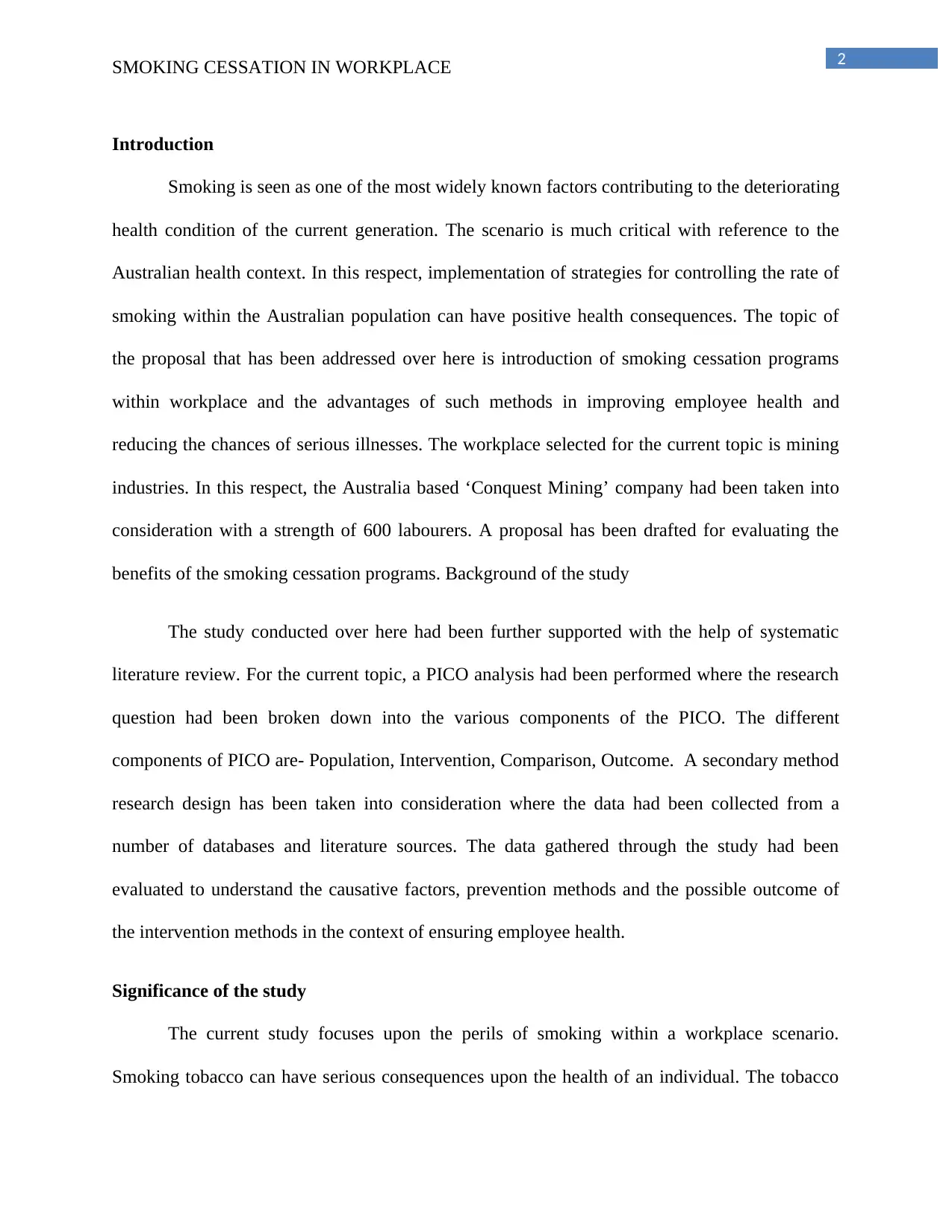
2SMOKING CESSATION IN WORKPLACE
Introduction
Smoking is seen as one of the most widely known factors contributing to the deteriorating
health condition of the current generation. The scenario is much critical with reference to the
Australian health context. In this respect, implementation of strategies for controlling the rate of
smoking within the Australian population can have positive health consequences. The topic of
the proposal that has been addressed over here is introduction of smoking cessation programs
within workplace and the advantages of such methods in improving employee health and
reducing the chances of serious illnesses. The workplace selected for the current topic is mining
industries. In this respect, the Australia based ‘Conquest Mining’ company had been taken into
consideration with a strength of 600 labourers. A proposal has been drafted for evaluating the
benefits of the smoking cessation programs. Background of the study
The study conducted over here had been further supported with the help of systematic
literature review. For the current topic, a PICO analysis had been performed where the research
question had been broken down into the various components of the PICO. The different
components of PICO are- Population, Intervention, Comparison, Outcome. A secondary method
research design has been taken into consideration where the data had been collected from a
number of databases and literature sources. The data gathered through the study had been
evaluated to understand the causative factors, prevention methods and the possible outcome of
the intervention methods in the context of ensuring employee health.
Significance of the study
The current study focuses upon the perils of smoking within a workplace scenario.
Smoking tobacco can have serious consequences upon the health of an individual. The tobacco
Introduction
Smoking is seen as one of the most widely known factors contributing to the deteriorating
health condition of the current generation. The scenario is much critical with reference to the
Australian health context. In this respect, implementation of strategies for controlling the rate of
smoking within the Australian population can have positive health consequences. The topic of
the proposal that has been addressed over here is introduction of smoking cessation programs
within workplace and the advantages of such methods in improving employee health and
reducing the chances of serious illnesses. The workplace selected for the current topic is mining
industries. In this respect, the Australia based ‘Conquest Mining’ company had been taken into
consideration with a strength of 600 labourers. A proposal has been drafted for evaluating the
benefits of the smoking cessation programs. Background of the study
The study conducted over here had been further supported with the help of systematic
literature review. For the current topic, a PICO analysis had been performed where the research
question had been broken down into the various components of the PICO. The different
components of PICO are- Population, Intervention, Comparison, Outcome. A secondary method
research design has been taken into consideration where the data had been collected from a
number of databases and literature sources. The data gathered through the study had been
evaluated to understand the causative factors, prevention methods and the possible outcome of
the intervention methods in the context of ensuring employee health.
Significance of the study
The current study focuses upon the perils of smoking within a workplace scenario.
Smoking tobacco can have serious consequences upon the health of an individual. The tobacco
⊘ This is a preview!⊘
Do you want full access?
Subscribe today to unlock all pages.

Trusted by 1+ million students worldwide
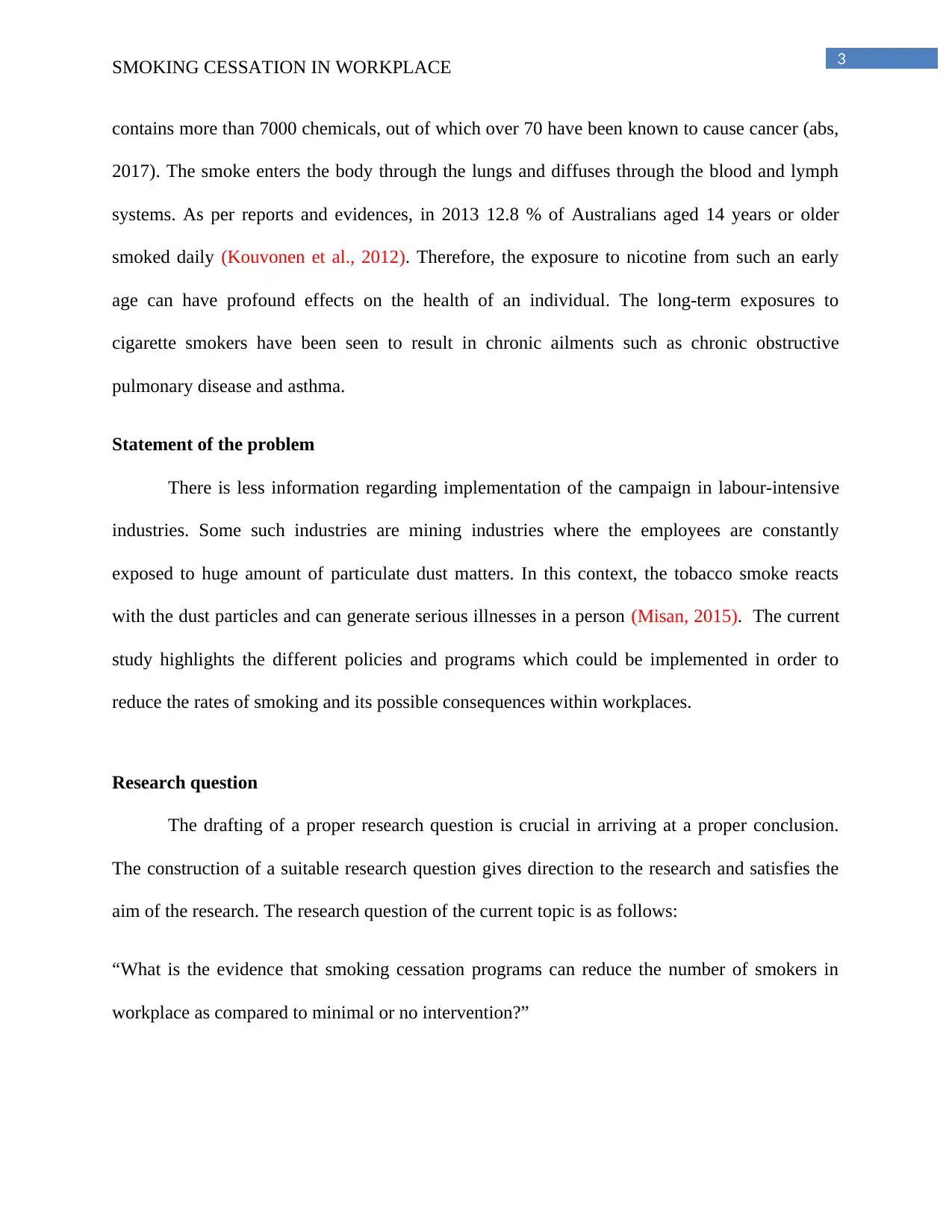
3SMOKING CESSATION IN WORKPLACE
contains more than 7000 chemicals, out of which over 70 have been known to cause cancer (abs,
2017). The smoke enters the body through the lungs and diffuses through the blood and lymph
systems. As per reports and evidences, in 2013 12.8 % of Australians aged 14 years or older
smoked daily (Kouvonen et al., 2012). Therefore, the exposure to nicotine from such an early
age can have profound effects on the health of an individual. The long-term exposures to
cigarette smokers have been seen to result in chronic ailments such as chronic obstructive
pulmonary disease and asthma.
Statement of the problem
There is less information regarding implementation of the campaign in labour-intensive
industries. Some such industries are mining industries where the employees are constantly
exposed to huge amount of particulate dust matters. In this context, the tobacco smoke reacts
with the dust particles and can generate serious illnesses in a person (Misan, 2015). The current
study highlights the different policies and programs which could be implemented in order to
reduce the rates of smoking and its possible consequences within workplaces.
Research question
The drafting of a proper research question is crucial in arriving at a proper conclusion.
The construction of a suitable research question gives direction to the research and satisfies the
aim of the research. The research question of the current topic is as follows:
“What is the evidence that smoking cessation programs can reduce the number of smokers in
workplace as compared to minimal or no intervention?”
contains more than 7000 chemicals, out of which over 70 have been known to cause cancer (abs,
2017). The smoke enters the body through the lungs and diffuses through the blood and lymph
systems. As per reports and evidences, in 2013 12.8 % of Australians aged 14 years or older
smoked daily (Kouvonen et al., 2012). Therefore, the exposure to nicotine from such an early
age can have profound effects on the health of an individual. The long-term exposures to
cigarette smokers have been seen to result in chronic ailments such as chronic obstructive
pulmonary disease and asthma.
Statement of the problem
There is less information regarding implementation of the campaign in labour-intensive
industries. Some such industries are mining industries where the employees are constantly
exposed to huge amount of particulate dust matters. In this context, the tobacco smoke reacts
with the dust particles and can generate serious illnesses in a person (Misan, 2015). The current
study highlights the different policies and programs which could be implemented in order to
reduce the rates of smoking and its possible consequences within workplaces.
Research question
The drafting of a proper research question is crucial in arriving at a proper conclusion.
The construction of a suitable research question gives direction to the research and satisfies the
aim of the research. The research question of the current topic is as follows:
“What is the evidence that smoking cessation programs can reduce the number of smokers in
workplace as compared to minimal or no intervention?”
Paraphrase This Document
Need a fresh take? Get an instant paraphrase of this document with our AI Paraphraser
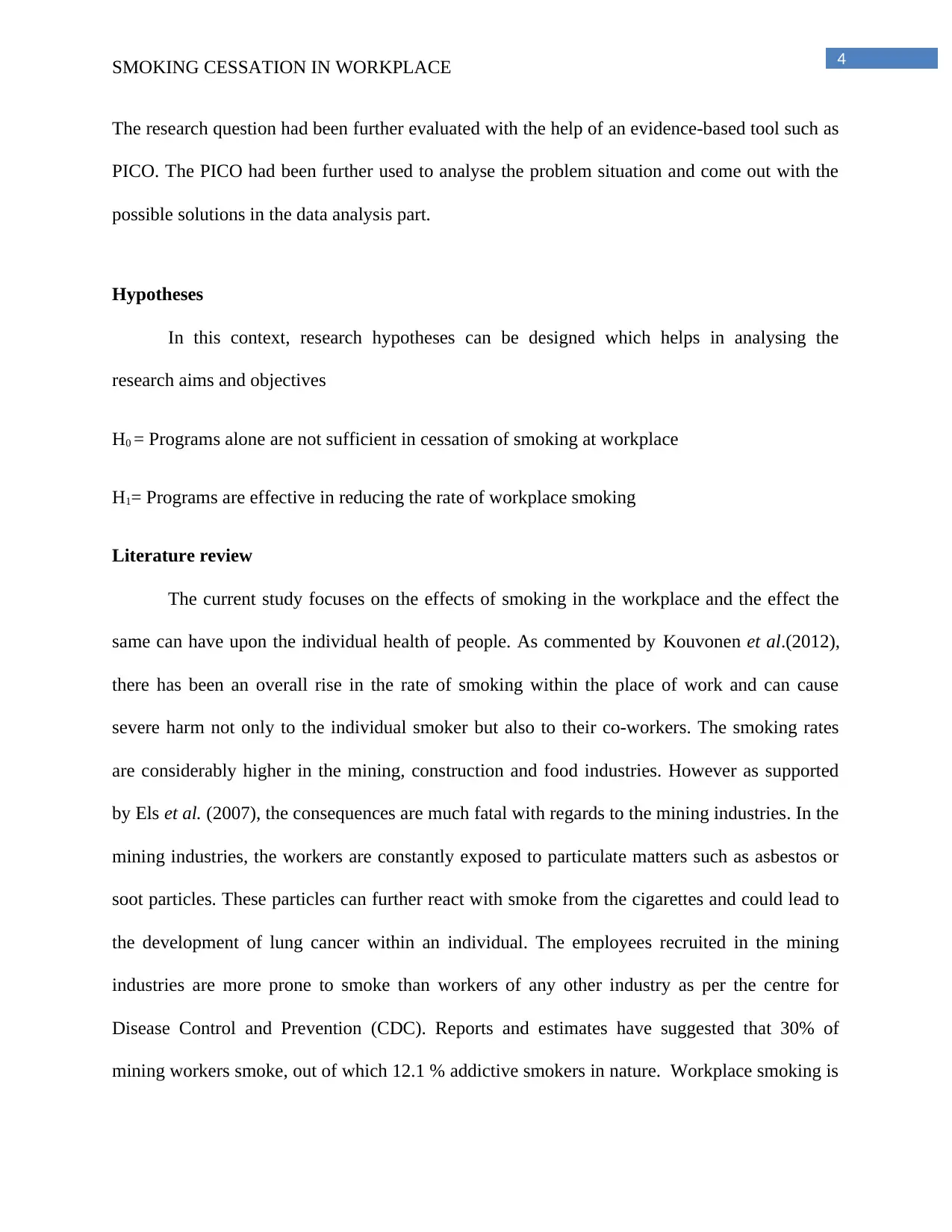
4SMOKING CESSATION IN WORKPLACE
The research question had been further evaluated with the help of an evidence-based tool such as
PICO. The PICO had been further used to analyse the problem situation and come out with the
possible solutions in the data analysis part.
Hypotheses
In this context, research hypotheses can be designed which helps in analysing the
research aims and objectives
H0 = Programs alone are not sufficient in cessation of smoking at workplace
H1= Programs are effective in reducing the rate of workplace smoking
Literature review
The current study focuses on the effects of smoking in the workplace and the effect the
same can have upon the individual health of people. As commented by Kouvonen et al.(2012),
there has been an overall rise in the rate of smoking within the place of work and can cause
severe harm not only to the individual smoker but also to their co-workers. The smoking rates
are considerably higher in the mining, construction and food industries. However as supported
by Els et al. (2007), the consequences are much fatal with regards to the mining industries. In the
mining industries, the workers are constantly exposed to particulate matters such as asbestos or
soot particles. These particles can further react with smoke from the cigarettes and could lead to
the development of lung cancer within an individual. The employees recruited in the mining
industries are more prone to smoke than workers of any other industry as per the centre for
Disease Control and Prevention (CDC). Reports and estimates have suggested that 30% of
mining workers smoke, out of which 12.1 % addictive smokers in nature. Workplace smoking is
The research question had been further evaluated with the help of an evidence-based tool such as
PICO. The PICO had been further used to analyse the problem situation and come out with the
possible solutions in the data analysis part.
Hypotheses
In this context, research hypotheses can be designed which helps in analysing the
research aims and objectives
H0 = Programs alone are not sufficient in cessation of smoking at workplace
H1= Programs are effective in reducing the rate of workplace smoking
Literature review
The current study focuses on the effects of smoking in the workplace and the effect the
same can have upon the individual health of people. As commented by Kouvonen et al.(2012),
there has been an overall rise in the rate of smoking within the place of work and can cause
severe harm not only to the individual smoker but also to their co-workers. The smoking rates
are considerably higher in the mining, construction and food industries. However as supported
by Els et al. (2007), the consequences are much fatal with regards to the mining industries. In the
mining industries, the workers are constantly exposed to particulate matters such as asbestos or
soot particles. These particles can further react with smoke from the cigarettes and could lead to
the development of lung cancer within an individual. The employees recruited in the mining
industries are more prone to smoke than workers of any other industry as per the centre for
Disease Control and Prevention (CDC). Reports and estimates have suggested that 30% of
mining workers smoke, out of which 12.1 % addictive smokers in nature. Workplace smoking is
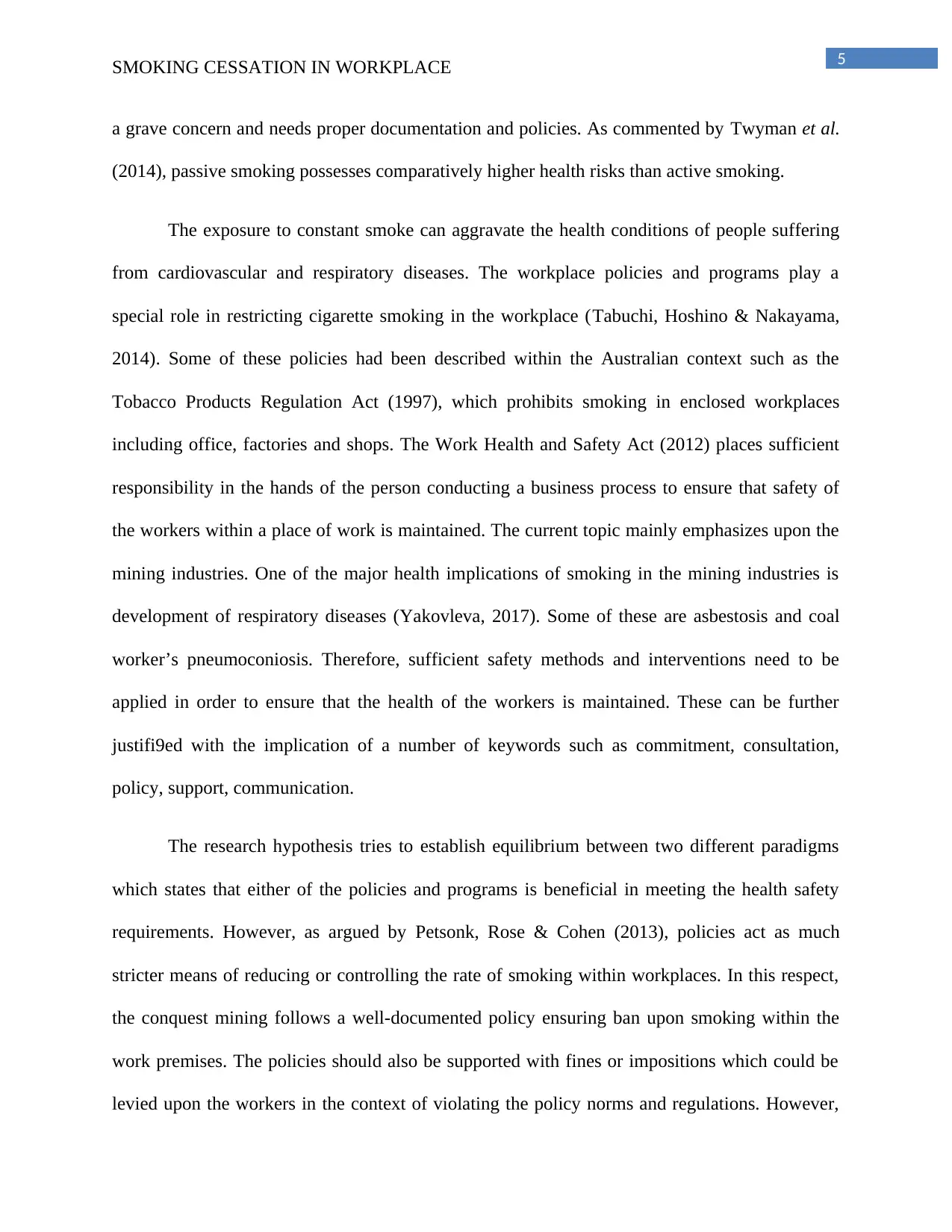
5SMOKING CESSATION IN WORKPLACE
a grave concern and needs proper documentation and policies. As commented by Twyman et al.
(2014), passive smoking possesses comparatively higher health risks than active smoking.
The exposure to constant smoke can aggravate the health conditions of people suffering
from cardiovascular and respiratory diseases. The workplace policies and programs play a
special role in restricting cigarette smoking in the workplace (Tabuchi, Hoshino & Nakayama,
2014). Some of these policies had been described within the Australian context such as the
Tobacco Products Regulation Act (1997), which prohibits smoking in enclosed workplaces
including office, factories and shops. The Work Health and Safety Act (2012) places sufficient
responsibility in the hands of the person conducting a business process to ensure that safety of
the workers within a place of work is maintained. The current topic mainly emphasizes upon the
mining industries. One of the major health implications of smoking in the mining industries is
development of respiratory diseases (Yakovleva, 2017). Some of these are asbestosis and coal
worker’s pneumoconiosis. Therefore, sufficient safety methods and interventions need to be
applied in order to ensure that the health of the workers is maintained. These can be further
justifi9ed with the implication of a number of keywords such as commitment, consultation,
policy, support, communication.
The research hypothesis tries to establish equilibrium between two different paradigms
which states that either of the policies and programs is beneficial in meeting the health safety
requirements. However, as argued by Petsonk, Rose & Cohen (2013), policies act as much
stricter means of reducing or controlling the rate of smoking within workplaces. In this respect,
the conquest mining follows a well-documented policy ensuring ban upon smoking within the
work premises. The policies should also be supported with fines or impositions which could be
levied upon the workers in the context of violating the policy norms and regulations. However,
a grave concern and needs proper documentation and policies. As commented by Twyman et al.
(2014), passive smoking possesses comparatively higher health risks than active smoking.
The exposure to constant smoke can aggravate the health conditions of people suffering
from cardiovascular and respiratory diseases. The workplace policies and programs play a
special role in restricting cigarette smoking in the workplace (Tabuchi, Hoshino & Nakayama,
2014). Some of these policies had been described within the Australian context such as the
Tobacco Products Regulation Act (1997), which prohibits smoking in enclosed workplaces
including office, factories and shops. The Work Health and Safety Act (2012) places sufficient
responsibility in the hands of the person conducting a business process to ensure that safety of
the workers within a place of work is maintained. The current topic mainly emphasizes upon the
mining industries. One of the major health implications of smoking in the mining industries is
development of respiratory diseases (Yakovleva, 2017). Some of these are asbestosis and coal
worker’s pneumoconiosis. Therefore, sufficient safety methods and interventions need to be
applied in order to ensure that the health of the workers is maintained. These can be further
justifi9ed with the implication of a number of keywords such as commitment, consultation,
policy, support, communication.
The research hypothesis tries to establish equilibrium between two different paradigms
which states that either of the policies and programs is beneficial in meeting the health safety
requirements. However, as argued by Petsonk, Rose & Cohen (2013), policies act as much
stricter means of reducing or controlling the rate of smoking within workplaces. In this respect,
the conquest mining follows a well-documented policy ensuring ban upon smoking within the
work premises. The policies should also be supported with fines or impositions which could be
levied upon the workers in the context of violating the policy norms and regulations. However,
⊘ This is a preview!⊘
Do you want full access?
Subscribe today to unlock all pages.

Trusted by 1+ million students worldwide
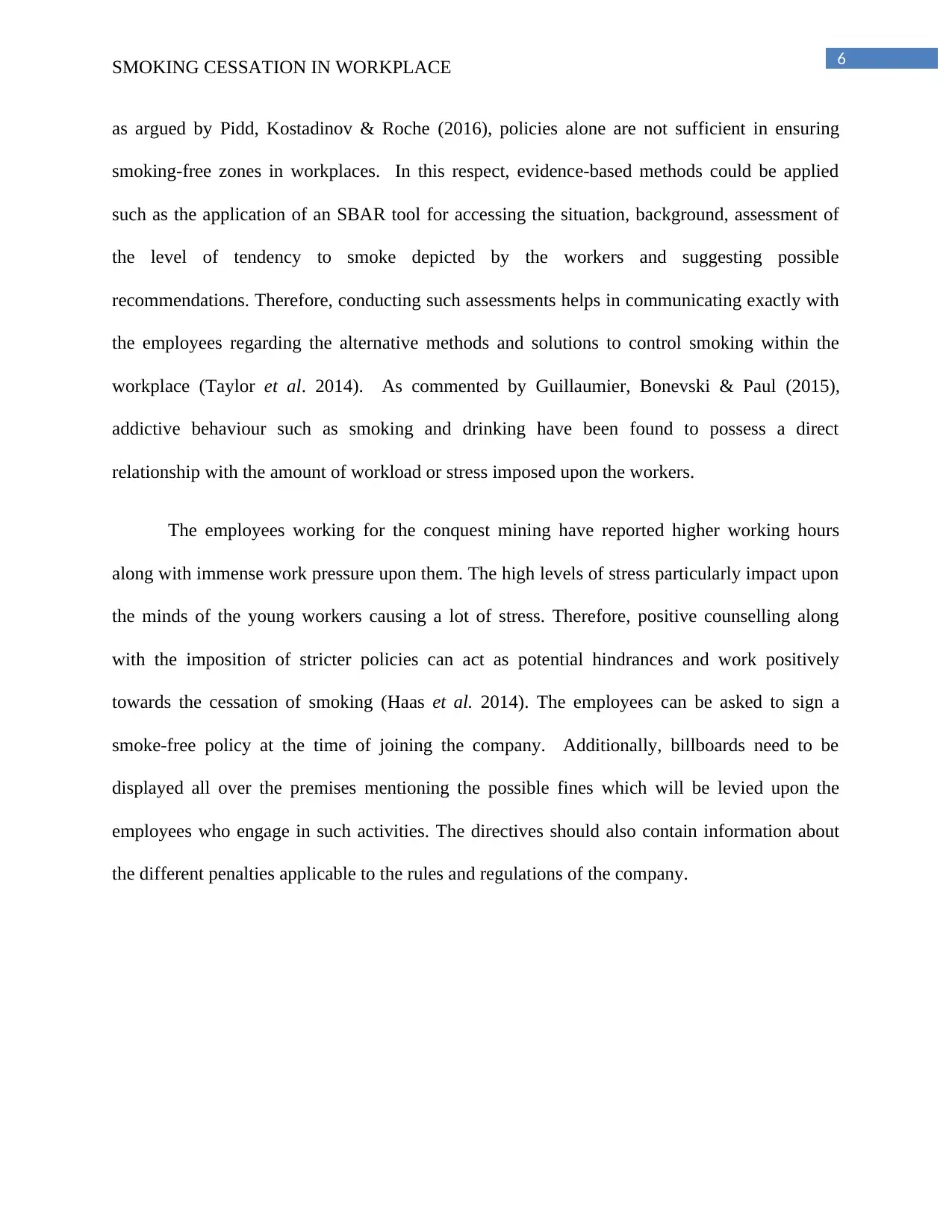
6SMOKING CESSATION IN WORKPLACE
as argued by Pidd, Kostadinov & Roche (2016), policies alone are not sufficient in ensuring
smoking-free zones in workplaces. In this respect, evidence-based methods could be applied
such as the application of an SBAR tool for accessing the situation, background, assessment of
the level of tendency to smoke depicted by the workers and suggesting possible
recommendations. Therefore, conducting such assessments helps in communicating exactly with
the employees regarding the alternative methods and solutions to control smoking within the
workplace (Taylor et al. 2014). As commented by Guillaumier, Bonevski & Paul (2015),
addictive behaviour such as smoking and drinking have been found to possess a direct
relationship with the amount of workload or stress imposed upon the workers.
The employees working for the conquest mining have reported higher working hours
along with immense work pressure upon them. The high levels of stress particularly impact upon
the minds of the young workers causing a lot of stress. Therefore, positive counselling along
with the imposition of stricter policies can act as potential hindrances and work positively
towards the cessation of smoking (Haas et al. 2014). The employees can be asked to sign a
smoke-free policy at the time of joining the company. Additionally, billboards need to be
displayed all over the premises mentioning the possible fines which will be levied upon the
employees who engage in such activities. The directives should also contain information about
the different penalties applicable to the rules and regulations of the company.
as argued by Pidd, Kostadinov & Roche (2016), policies alone are not sufficient in ensuring
smoking-free zones in workplaces. In this respect, evidence-based methods could be applied
such as the application of an SBAR tool for accessing the situation, background, assessment of
the level of tendency to smoke depicted by the workers and suggesting possible
recommendations. Therefore, conducting such assessments helps in communicating exactly with
the employees regarding the alternative methods and solutions to control smoking within the
workplace (Taylor et al. 2014). As commented by Guillaumier, Bonevski & Paul (2015),
addictive behaviour such as smoking and drinking have been found to possess a direct
relationship with the amount of workload or stress imposed upon the workers.
The employees working for the conquest mining have reported higher working hours
along with immense work pressure upon them. The high levels of stress particularly impact upon
the minds of the young workers causing a lot of stress. Therefore, positive counselling along
with the imposition of stricter policies can act as potential hindrances and work positively
towards the cessation of smoking (Haas et al. 2014). The employees can be asked to sign a
smoke-free policy at the time of joining the company. Additionally, billboards need to be
displayed all over the premises mentioning the possible fines which will be levied upon the
employees who engage in such activities. The directives should also contain information about
the different penalties applicable to the rules and regulations of the company.
Paraphrase This Document
Need a fresh take? Get an instant paraphrase of this document with our AI Paraphraser
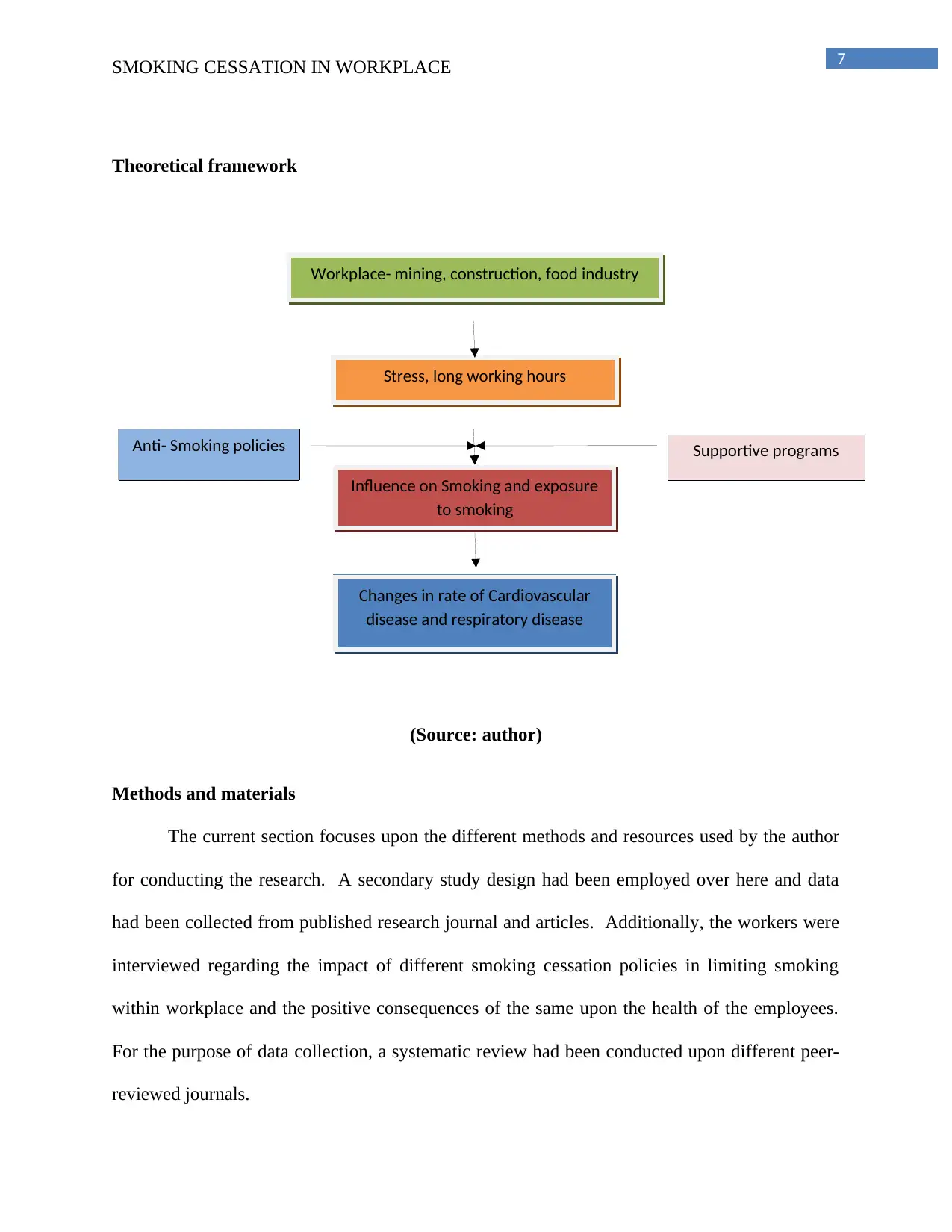
7SMOKING CESSATION IN WORKPLACE
Theoretical framework
(Source: author)
Methods and materials
The current section focuses upon the different methods and resources used by the author
for conducting the research. A secondary study design had been employed over here and data
had been collected from published research journal and articles. Additionally, the workers were
interviewed regarding the impact of different smoking cessation policies in limiting smoking
within workplace and the positive consequences of the same upon the health of the employees.
For the purpose of data collection, a systematic review had been conducted upon different peer-
reviewed journals.
Anti- Smoking policies Supportive programs
Workplace- mining, construction, food industry
Stress, long working hours
Influence on Smoking and exposure
to smoking
Changes in rate of Cardiovascular
disease and respiratory disease
Theoretical framework
(Source: author)
Methods and materials
The current section focuses upon the different methods and resources used by the author
for conducting the research. A secondary study design had been employed over here and data
had been collected from published research journal and articles. Additionally, the workers were
interviewed regarding the impact of different smoking cessation policies in limiting smoking
within workplace and the positive consequences of the same upon the health of the employees.
For the purpose of data collection, a systematic review had been conducted upon different peer-
reviewed journals.
Anti- Smoking policies Supportive programs
Workplace- mining, construction, food industry
Stress, long working hours
Influence on Smoking and exposure
to smoking
Changes in rate of Cardiovascular
disease and respiratory disease
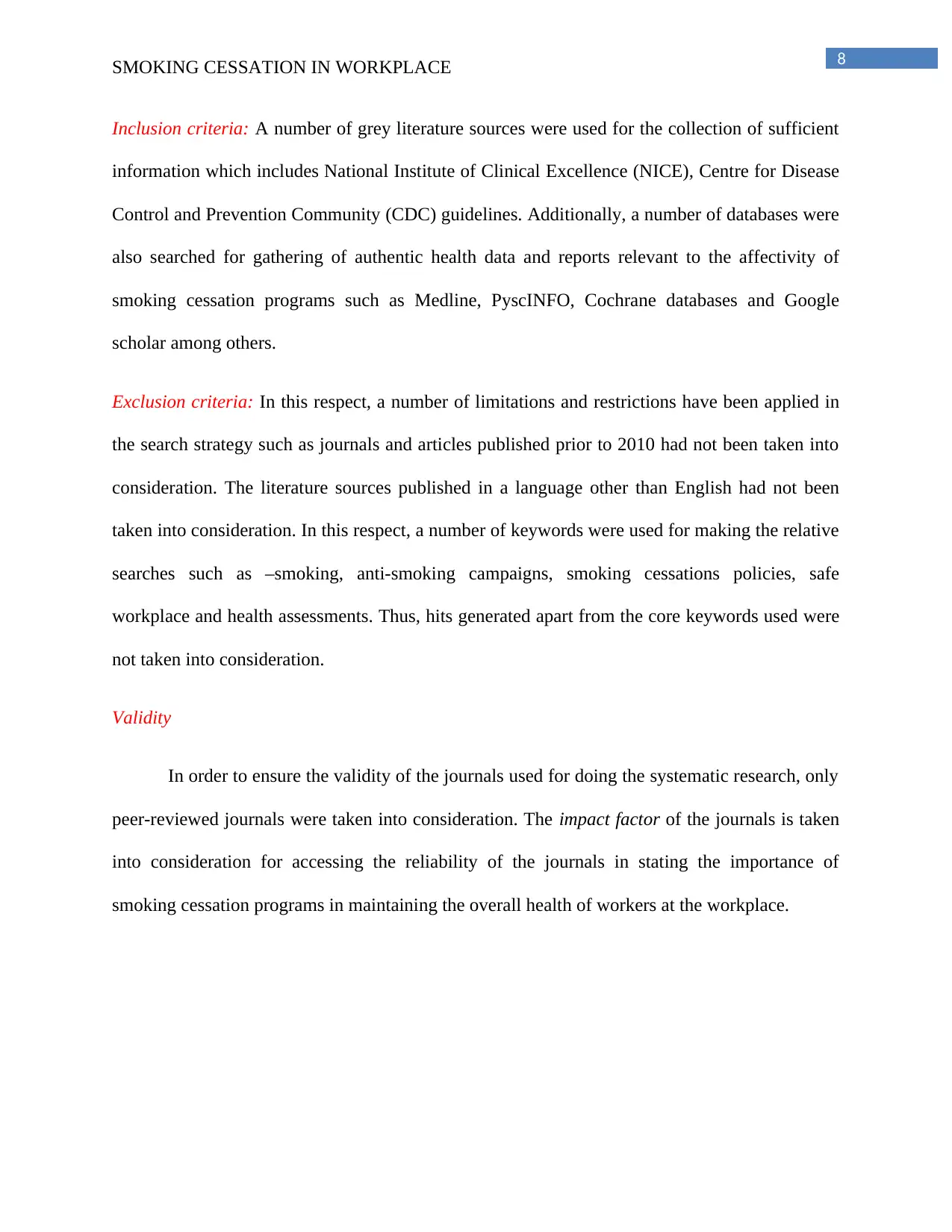
8SMOKING CESSATION IN WORKPLACE
Inclusion criteria: A number of grey literature sources were used for the collection of sufficient
information which includes National Institute of Clinical Excellence (NICE), Centre for Disease
Control and Prevention Community (CDC) guidelines. Additionally, a number of databases were
also searched for gathering of authentic health data and reports relevant to the affectivity of
smoking cessation programs such as Medline, PyscINFO, Cochrane databases and Google
scholar among others.
Exclusion criteria: In this respect, a number of limitations and restrictions have been applied in
the search strategy such as journals and articles published prior to 2010 had not been taken into
consideration. The literature sources published in a language other than English had not been
taken into consideration. In this respect, a number of keywords were used for making the relative
searches such as –smoking, anti-smoking campaigns, smoking cessations policies, safe
workplace and health assessments. Thus, hits generated apart from the core keywords used were
not taken into consideration.
Validity
In order to ensure the validity of the journals used for doing the systematic research, only
peer-reviewed journals were taken into consideration. The impact factor of the journals is taken
into consideration for accessing the reliability of the journals in stating the importance of
smoking cessation programs in maintaining the overall health of workers at the workplace.
Inclusion criteria: A number of grey literature sources were used for the collection of sufficient
information which includes National Institute of Clinical Excellence (NICE), Centre for Disease
Control and Prevention Community (CDC) guidelines. Additionally, a number of databases were
also searched for gathering of authentic health data and reports relevant to the affectivity of
smoking cessation programs such as Medline, PyscINFO, Cochrane databases and Google
scholar among others.
Exclusion criteria: In this respect, a number of limitations and restrictions have been applied in
the search strategy such as journals and articles published prior to 2010 had not been taken into
consideration. The literature sources published in a language other than English had not been
taken into consideration. In this respect, a number of keywords were used for making the relative
searches such as –smoking, anti-smoking campaigns, smoking cessations policies, safe
workplace and health assessments. Thus, hits generated apart from the core keywords used were
not taken into consideration.
Validity
In order to ensure the validity of the journals used for doing the systematic research, only
peer-reviewed journals were taken into consideration. The impact factor of the journals is taken
into consideration for accessing the reliability of the journals in stating the importance of
smoking cessation programs in maintaining the overall health of workers at the workplace.
⊘ This is a preview!⊘
Do you want full access?
Subscribe today to unlock all pages.

Trusted by 1+ million students worldwide
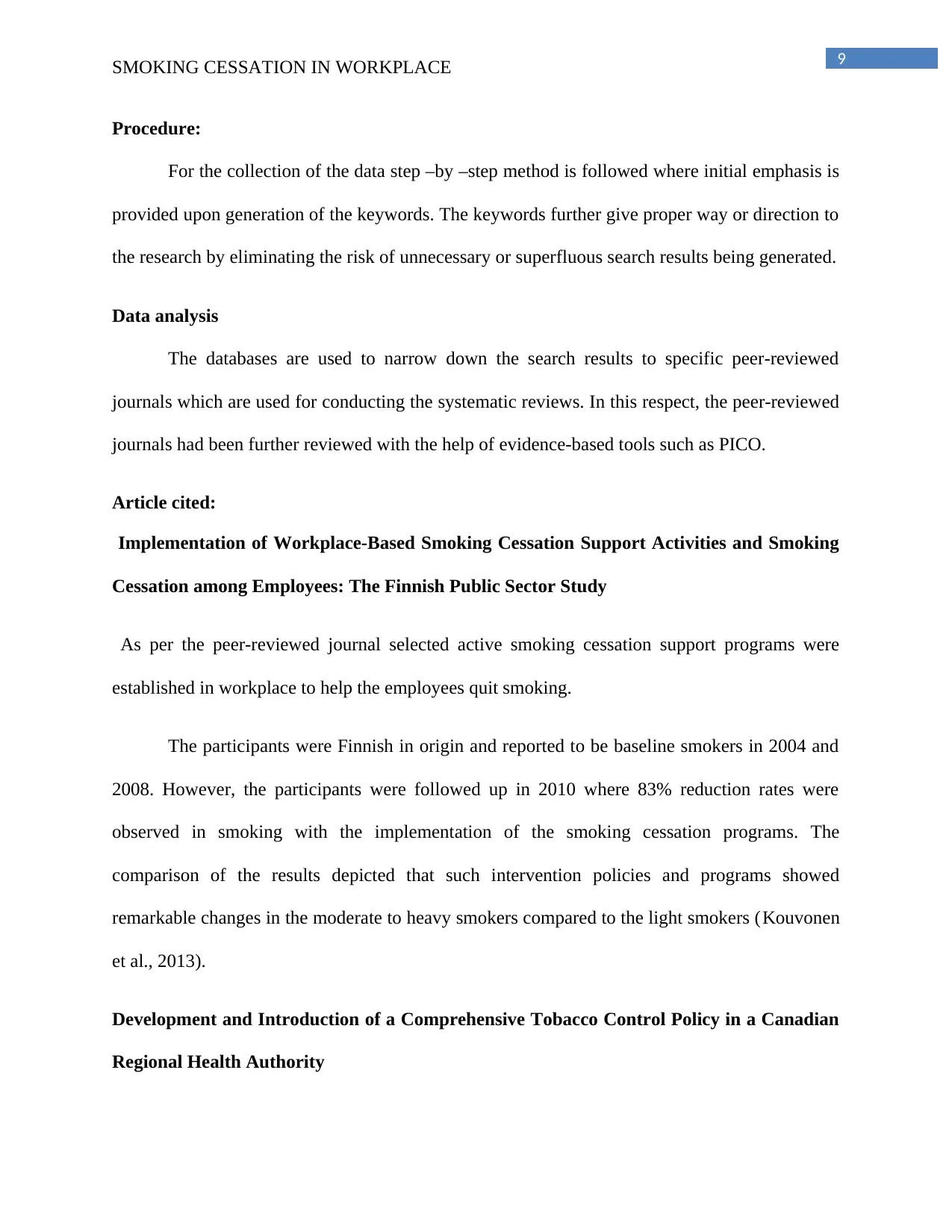
9SMOKING CESSATION IN WORKPLACE
Procedure:
For the collection of the data step –by –step method is followed where initial emphasis is
provided upon generation of the keywords. The keywords further give proper way or direction to
the research by eliminating the risk of unnecessary or superfluous search results being generated.
Data analysis
The databases are used to narrow down the search results to specific peer-reviewed
journals which are used for conducting the systematic reviews. In this respect, the peer-reviewed
journals had been further reviewed with the help of evidence-based tools such as PICO.
Article cited:
Implementation of Workplace-Based Smoking Cessation Support Activities and Smoking
Cessation among Employees: The Finnish Public Sector Study
As per the peer-reviewed journal selected active smoking cessation support programs were
established in workplace to help the employees quit smoking.
The participants were Finnish in origin and reported to be baseline smokers in 2004 and
2008. However, the participants were followed up in 2010 where 83% reduction rates were
observed in smoking with the implementation of the smoking cessation programs. The
comparison of the results depicted that such intervention policies and programs showed
remarkable changes in the moderate to heavy smokers compared to the light smokers (Kouvonen
et al., 2013).
Development and Introduction of a Comprehensive Tobacco Control Policy in a Canadian
Regional Health Authority
Procedure:
For the collection of the data step –by –step method is followed where initial emphasis is
provided upon generation of the keywords. The keywords further give proper way or direction to
the research by eliminating the risk of unnecessary or superfluous search results being generated.
Data analysis
The databases are used to narrow down the search results to specific peer-reviewed
journals which are used for conducting the systematic reviews. In this respect, the peer-reviewed
journals had been further reviewed with the help of evidence-based tools such as PICO.
Article cited:
Implementation of Workplace-Based Smoking Cessation Support Activities and Smoking
Cessation among Employees: The Finnish Public Sector Study
As per the peer-reviewed journal selected active smoking cessation support programs were
established in workplace to help the employees quit smoking.
The participants were Finnish in origin and reported to be baseline smokers in 2004 and
2008. However, the participants were followed up in 2010 where 83% reduction rates were
observed in smoking with the implementation of the smoking cessation programs. The
comparison of the results depicted that such intervention policies and programs showed
remarkable changes in the moderate to heavy smokers compared to the light smokers (Kouvonen
et al., 2013).
Development and Introduction of a Comprehensive Tobacco Control Policy in a Canadian
Regional Health Authority
Paraphrase This Document
Need a fresh take? Get an instant paraphrase of this document with our AI Paraphraser
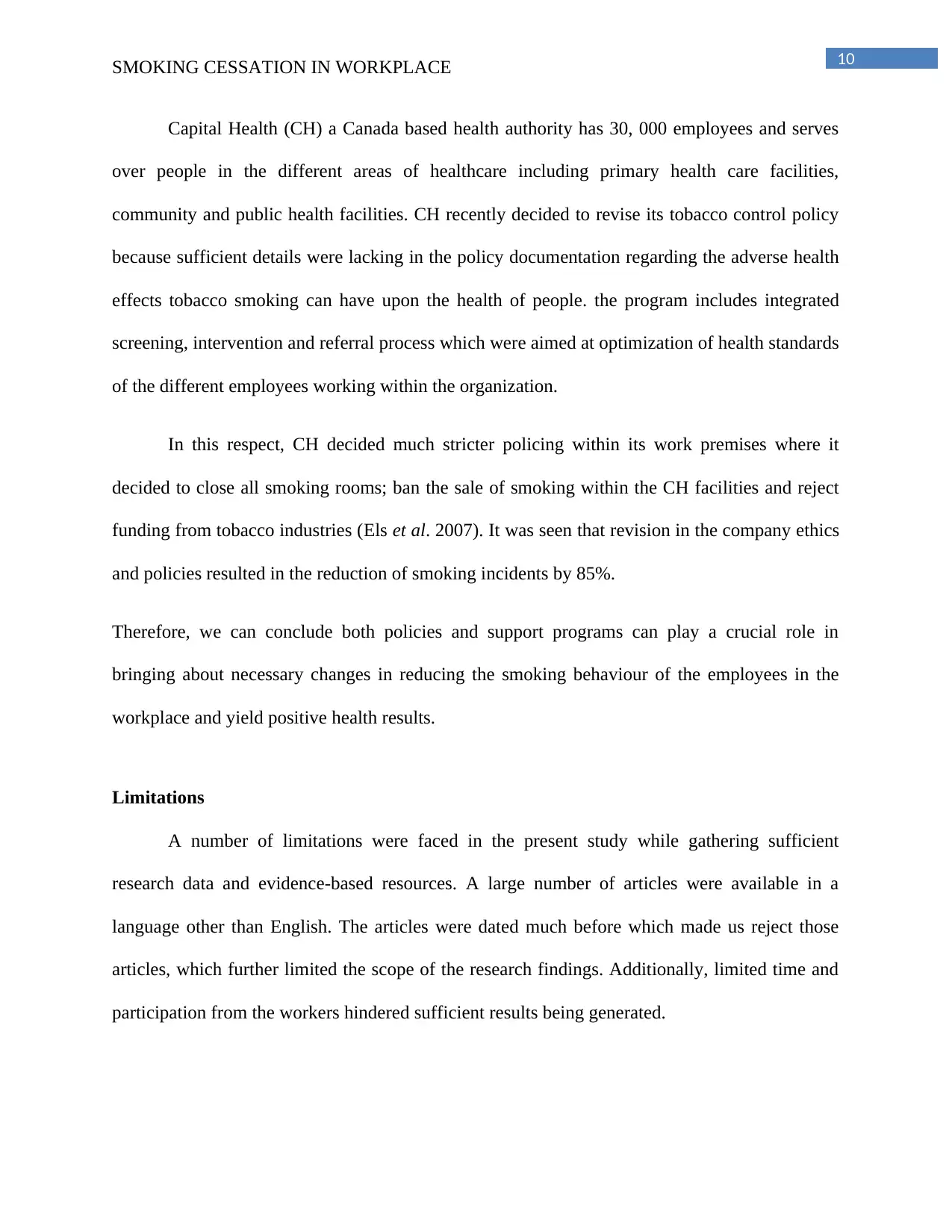
10SMOKING CESSATION IN WORKPLACE
Capital Health (CH) a Canada based health authority has 30, 000 employees and serves
over people in the different areas of healthcare including primary health care facilities,
community and public health facilities. CH recently decided to revise its tobacco control policy
because sufficient details were lacking in the policy documentation regarding the adverse health
effects tobacco smoking can have upon the health of people. the program includes integrated
screening, intervention and referral process which were aimed at optimization of health standards
of the different employees working within the organization.
In this respect, CH decided much stricter policing within its work premises where it
decided to close all smoking rooms; ban the sale of smoking within the CH facilities and reject
funding from tobacco industries (Els et al. 2007). It was seen that revision in the company ethics
and policies resulted in the reduction of smoking incidents by 85%.
Therefore, we can conclude both policies and support programs can play a crucial role in
bringing about necessary changes in reducing the smoking behaviour of the employees in the
workplace and yield positive health results.
Limitations
A number of limitations were faced in the present study while gathering sufficient
research data and evidence-based resources. A large number of articles were available in a
language other than English. The articles were dated much before which made us reject those
articles, which further limited the scope of the research findings. Additionally, limited time and
participation from the workers hindered sufficient results being generated.
Capital Health (CH) a Canada based health authority has 30, 000 employees and serves
over people in the different areas of healthcare including primary health care facilities,
community and public health facilities. CH recently decided to revise its tobacco control policy
because sufficient details were lacking in the policy documentation regarding the adverse health
effects tobacco smoking can have upon the health of people. the program includes integrated
screening, intervention and referral process which were aimed at optimization of health standards
of the different employees working within the organization.
In this respect, CH decided much stricter policing within its work premises where it
decided to close all smoking rooms; ban the sale of smoking within the CH facilities and reject
funding from tobacco industries (Els et al. 2007). It was seen that revision in the company ethics
and policies resulted in the reduction of smoking incidents by 85%.
Therefore, we can conclude both policies and support programs can play a crucial role in
bringing about necessary changes in reducing the smoking behaviour of the employees in the
workplace and yield positive health results.
Limitations
A number of limitations were faced in the present study while gathering sufficient
research data and evidence-based resources. A large number of articles were available in a
language other than English. The articles were dated much before which made us reject those
articles, which further limited the scope of the research findings. Additionally, limited time and
participation from the workers hindered sufficient results being generated.
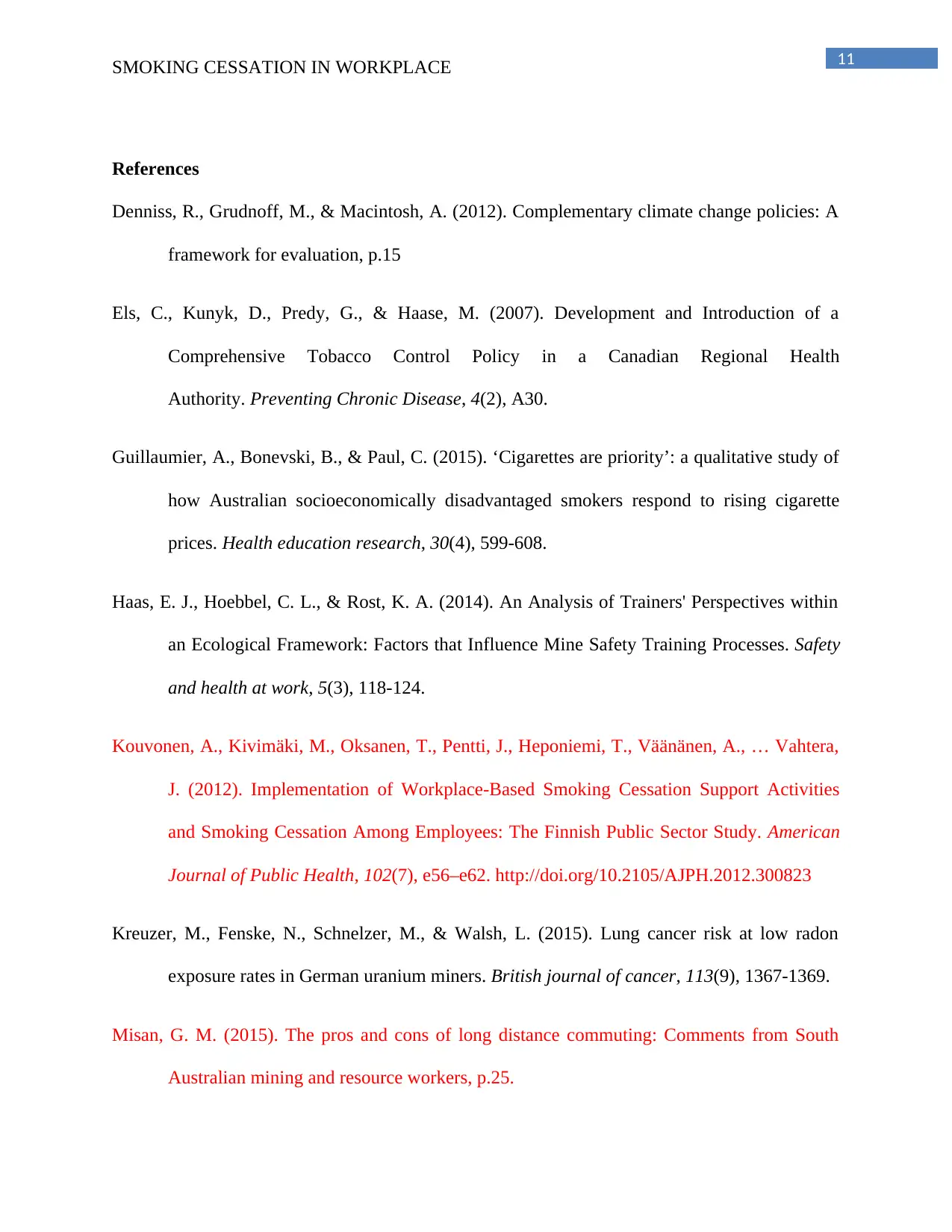
11SMOKING CESSATION IN WORKPLACE
References
Denniss, R., Grudnoff, M., & Macintosh, A. (2012). Complementary climate change policies: A
framework for evaluation, p.15
Els, C., Kunyk, D., Predy, G., & Haase, M. (2007). Development and Introduction of a
Comprehensive Tobacco Control Policy in a Canadian Regional Health
Authority. Preventing Chronic Disease, 4(2), A30.
Guillaumier, A., Bonevski, B., & Paul, C. (2015). ‘Cigarettes are priority’: a qualitative study of
how Australian socioeconomically disadvantaged smokers respond to rising cigarette
prices. Health education research, 30(4), 599-608.
Haas, E. J., Hoebbel, C. L., & Rost, K. A. (2014). An Analysis of Trainers' Perspectives within
an Ecological Framework: Factors that Influence Mine Safety Training Processes. Safety
and health at work, 5(3), 118-124.
Kouvonen, A., Kivimäki, M., Oksanen, T., Pentti, J., Heponiemi, T., Väänänen, A., … Vahtera,
J. (2012). Implementation of Workplace-Based Smoking Cessation Support Activities
and Smoking Cessation Among Employees: The Finnish Public Sector Study. American
Journal of Public Health, 102(7), e56–e62. http://doi.org/10.2105/AJPH.2012.300823
Kreuzer, M., Fenske, N., Schnelzer, M., & Walsh, L. (2015). Lung cancer risk at low radon
exposure rates in German uranium miners. British journal of cancer, 113(9), 1367-1369.
Misan, G. M. (2015). The pros and cons of long distance commuting: Comments from South
Australian mining and resource workers, p.25.
References
Denniss, R., Grudnoff, M., & Macintosh, A. (2012). Complementary climate change policies: A
framework for evaluation, p.15
Els, C., Kunyk, D., Predy, G., & Haase, M. (2007). Development and Introduction of a
Comprehensive Tobacco Control Policy in a Canadian Regional Health
Authority. Preventing Chronic Disease, 4(2), A30.
Guillaumier, A., Bonevski, B., & Paul, C. (2015). ‘Cigarettes are priority’: a qualitative study of
how Australian socioeconomically disadvantaged smokers respond to rising cigarette
prices. Health education research, 30(4), 599-608.
Haas, E. J., Hoebbel, C. L., & Rost, K. A. (2014). An Analysis of Trainers' Perspectives within
an Ecological Framework: Factors that Influence Mine Safety Training Processes. Safety
and health at work, 5(3), 118-124.
Kouvonen, A., Kivimäki, M., Oksanen, T., Pentti, J., Heponiemi, T., Väänänen, A., … Vahtera,
J. (2012). Implementation of Workplace-Based Smoking Cessation Support Activities
and Smoking Cessation Among Employees: The Finnish Public Sector Study. American
Journal of Public Health, 102(7), e56–e62. http://doi.org/10.2105/AJPH.2012.300823
Kreuzer, M., Fenske, N., Schnelzer, M., & Walsh, L. (2015). Lung cancer risk at low radon
exposure rates in German uranium miners. British journal of cancer, 113(9), 1367-1369.
Misan, G. M. (2015). The pros and cons of long distance commuting: Comments from South
Australian mining and resource workers, p.25.
⊘ This is a preview!⊘
Do you want full access?
Subscribe today to unlock all pages.

Trusted by 1+ million students worldwide
1 out of 15
Related Documents
Your All-in-One AI-Powered Toolkit for Academic Success.
+13062052269
info@desklib.com
Available 24*7 on WhatsApp / Email
![[object Object]](/_next/static/media/star-bottom.7253800d.svg)
Unlock your academic potential
Copyright © 2020–2025 A2Z Services. All Rights Reserved. Developed and managed by ZUCOL.





